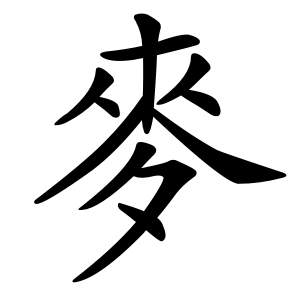麥
- barley, wheat;
- oats;
It is more commonly used to refer specifically to wheat.
Etymology
The character is a phono-semantic compound, composed of 來 (“to come”) and 夂 (“go slowly” or “legs”), though interpretations vary.
Some believe 夂 depicts a person’s legs, while others think it symbolizes long roots of cereal plants.
Originally, 來 meant wheat, but once its meaning shifted to “come,” the character 麥 was created to continue representing wheat.
Usage in Korean
It is a general term for cereal crops in the grass family, especially wheat.
It can refer to wheat directly, or to wheat and barley collectively.
When used as a radical, 麥 conveys meanings related to grains, wheat, or food.
Examples:
麪 (밀가루 면, flour or noodles)
䴵 (가루떡 병, rice cake powder)
麭 (떡 포, rice cake or pastry)
Additional notes
There is a separate character, 麰 (mo), that refers specifically to barley.
Similar shape characters
Important: The radical of 麥 is not 夂, but 麥 itself—it is a standalone radical.
Characters with 麥
Words that derived from 麥
- 十人弓戈 (JONI)
- ⿱ 來 夊
